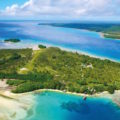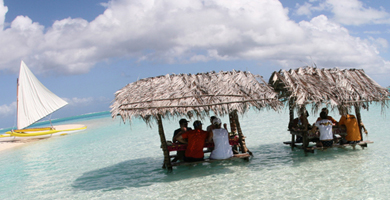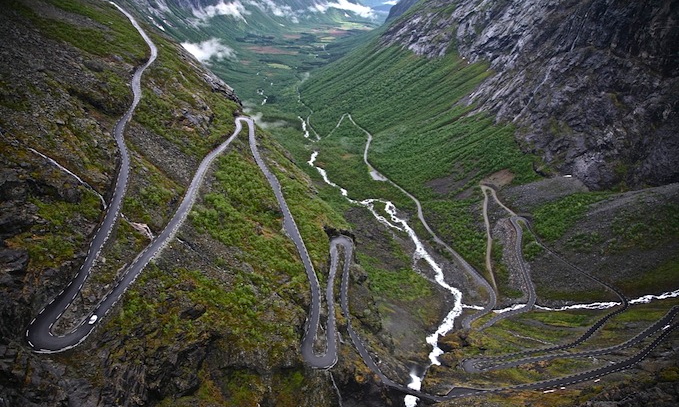Exploring Norway's Lofoten Islands
Michael Webb heads from Å to BØ by land and sea discovering Norway’s scenic delights.
On the Lofoten islands, off the northern coast of Norway, you can climb a mountain, row in a Viking long boat (horned helmets optional), and stay in a fisherman’s cabin in villages called Å and Bø. Cod love the Lofoten and come here to spawn in winter; for a couple of months the fishing villages bustle with activity, before the cod are split and put out to dry on wooden frames. That’s the best season to enjoy the Northern Lights, and the Gulf Stream keeps the temperature just above zero (when inland communities this far above the Arctic Circle can be a frigid 40 below). The Lofoten are increasingly popular in summer, so I got ahead of the rush and went there in mid-June, flying from Oslo to Bodo, driving to Skutvik, and taking the ferry to Svolvaer, the only sizeable town on the Lofoten. Its waterfront is lined with generic glass hotels and upscale apartments, which is not what I came so far to see.
Instead, I stayed in Henningsvaer, a pretty fishing village 30 minutes south, which has several modest hotels and restaurants, and has remained unspoiled. Wood cottages and warehouses line the deep harbor, and a network of narrow lanes lead off the one main road. Beyond, granite rocks rise from the waters of the sound, and a white concrete cube, formerly a fish processing plant, has been given a new role as a cutting-edge art gallery. The Finnholmen Brygge, a simple red boarded inn on the water, offers basic comforts and friendly service. Fiskekrogen restaurant is famed for its creamy fish soup, and a seasonal menu that included pan-fried cod with baked root vegetables, and roast lamb. Henningsvaer Brygge is the best hotel in town and has an excellent restaurant, though the night I went, everyone but me was eating whale.
The four main Lofoten islands are linked by single-span bridges along the E 10 highway. A jagged wall of mountains divides the islands in two and the landscape is a mix of inlets and islets, tumbled rocks richly encrusted with lichens, and granite outcrops scoured smooth by glaciers. The lower slopes are covered with moss and wild flowers, but trees are rare. A succession of fishing villages hug the inlets, each with its wood houses, painted dark red or yellow ochre, with white trim, perched on stilts or rocks. By now, most of the itinerant fishermen had left, and the frames were empty, for the dried cod had been shipped to Spain and Portugal. A few campers, mostly Norwegian or German, chug along the main road, but it’s easy to have a solitary commune with nature. Paths lead down to white sand beaches, though the water is chilly year round. This is great country for hiking and biking, and, further north, you can go on a whale-watching expedition or get a close-up view of puffins.
Nusfjord, is a museum village that charges an admission fee, and Å, at the end of the E 10, can be touristy, but there are plenty of alternatives to explore or stay in like a modernized rorbuer—in which fishermen shared beds and an outdoor privy. Reine is a particularly good bet and there’s a ferry that runs direct to Bodo once a day from the neighboring port. Inland, you should try to get inside Flakstad church: an odd mix of log cabin and graceful baroque furnishings, plus a suspended ship model– something you’ll find in every mariners’ church in Scandinavia. Close by, the Lofotr Viking Museum is located on the site of a chieftain’s hall that was excavated in the 1980s. Videos tell the story along with artifacts from the graves, and the estate includes a recreation of the hall, a primitive hut, and a long boat that visitors can row on the lake.
June is the season of the midnight sun, but it rarely appeared in the four days I was there. The Lofoten open onto the Norwegian Sea (really, the Atlantic) and—as in Ireland and the Scottish Highlands—the weather is erratic. I met a parish priest who said it had been 27 degrees Celsius two weeks before; now it was seven degrees and the mountains were veiled in mist. This made the landscapes even more ethereal and mysterious. On my last day, lunching in the Climbers’ Cafe in Henningsvaer (a point of departure for skilled and neophyte mountaineers) the sun appeared, and I raced out to capture that rare moment. The patterns of light and shade gave the village another dimension, and you could see how inventively the houses—as simple as those on a Monopoly board—were painted and sited. I drove the coast road to Leknes (# 815), a spectacular alternative to E10, winding between sheer mountains and shore, soaking up impressions of this earthly paradise.
Michael Webb
around the world.
Latest posts by Michael Webb
- DESTINATION: Revisiting the South of France - April 30, 2024
- Exploring the Czech Republic - January 29, 2024
- Rediscovering Morocco - April 6, 2022















[…] if you happen to be in Norway, you must go the the Lofotr Viking Museum in Northern … Exploring Norway’s Lofoten Islands | Wandermelon: The ultimate … Nusfjord, Norway Lofotr Viking Museum, Norway Flakstad church, Norway. Nusfjord, is a museum […]